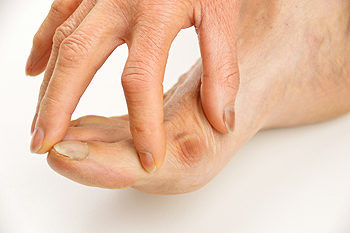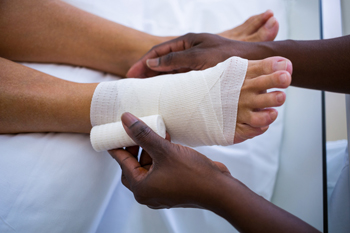Items filtered by date: July 2023
Possible Causes of Hammertoe

Hammertoe is easy to notice. It is a foot condition that causes the second or third toe to bend up at the middle joint and may be caused by shoes that are the incorrect size. This is a common condition among people who wear high heels or tight shoes, and in severe cases, it may be difficult to walk. Many people develop corns on top of the hammertoes, caused by the toes constantly rubbing against the top of the shoe. In mild cases, some stretches can gradually straighten the toes. This can be coupled with wearing protective pads on top of the toes, which may help reduce friction. Some people choose to wear orthotics, which may help realign the foot. If you have developed hammertoe, it is strongly suggested that you consult with a podiatrist who can effectively diagnose and treat this condition.
Hammertoes can be a painful condition to live with. For more information, contact Dr. Mark Gagnon of Advanced Podiatry. Our doctor will answer any of your foot- and ankle-related questions.
Hammertoe
Hammertoe is a foot deformity that occurs due to an imbalance in the muscles, tendons, or ligaments that normally hold the toe straight. It can be caused by the type of shoes you wear, your foot structure, trauma, and certain disease processes.
Symptoms
- Painful and/or difficult toe movement
- Swelling
- Joint stiffness
- Calluses/Corns
- Physical deformity
Risk Factors
- Age – The risk of hammertoe increases with age
- Sex – Women are more likely to have hammertoe compared to men
- Toe Length – You are more likely to develop hammertoe if your second toe is longer than your big toe
- Certain Diseases – Arthritis and diabetes may make you more likely to develop hammertoe
Treatment
If you have hammertoe, you should change into a more comfortable shoe that provides enough room for your toes. Exercises such as picking up marbles may strengthen and stretch your toe muscles. Nevertheless, it is important to seek assistance from a podiatrist in order to determine the severity of your hammertoe and see which treatment option will work best for you.
If you have any questions, please feel free to contact one of our offices located in Crestwood, Orland Park, and Summit, IL . We offer the newest diagnostic and treatment technologies for all your foot care needs.
Why Do Bunions Develop?

A bunion is a bone disorder that is on the side of the big toe, and it will gradually become larger if treatment is not received. Bunions can develop as a result of wearing shoes that do not have enough room in the toe area to move freely in. Severe bunions may cause the other toes to shift together and larger shoes may need to be purchased. Some people are born with an abnormal foot structure causing the feet to be out of alignment. This may affect the metatarsophalangeal joint, possibly causing a bunion to form. Overpronation, or the amount the foot rolls inward while walking, may lead to a bunion developing. Additionally, people who have flat feet may have bunions, and wearing orthotics may help to stabilize the arch of the foot. A protective pad can be worn over the bunion to help prevent corns from developing on top of it. This can happen as the top of the bunion rubs against the shoe, causing pain and discomfort. If you have a bunion, it is strongly suggested that you are under the care of a podiatrist who can help you with permanent relief options.
If you are suffering from bunion pain, contact Dr. Mark Gagnon of Advanced Podiatry. Our doctor can provide the care you need to keep you pain-free and on your feet.
What Is a Bunion?
Bunions are painful bony bumps that usually develop on the inside of the foot at the joint of the big toe. As the deformity increases over time, it may become painful to walk and wear shoes. Women are more likely to exacerbate existing bunions since they often wear tight, narrow shoes that shift their toes together. Bunion pain can be relieved by wearing wider shoes with enough room for the toes.
Causes
- Genetics – some people inherit feet that are more prone to bunion development
- Inflammatory Conditions - rheumatoid arthritis and polio may cause bunion development
Symptoms
- Redness and inflammation
- Pain and tenderness
- Callus or corns on the bump
- Restricted motion in the big toe
In order to diagnose your bunion, your podiatrist may ask about your medical history, symptoms, and general health. Your doctor might also order an x-ray to take a closer look at your feet. Nonsurgical treatment options include orthotics, padding, icing, changes in footwear, and medication. If nonsurgical treatments don’t alleviate your bunion pain, surgery may be necessary.
If you have any questions, please feel free to contact one of our offices located in Crestwood, Orland Park, and Summit, IL . We offer the newest diagnostic and treatment technologies for all your foot care needs.
What Can Cause Gout?

The foot condition that is known as gout can happen suddenly. It is accompanied by severe pain and discomfort, and it is often difficult to walk. It is an ailment that affects the joints in the big toe, causing it to throb and have a burning sensation. Gout can happen if there is a family history of it occurring or possibly from the foods that are eaten. These types of foods have purines in them and include red meat, shellfish, and drinks that are made with large amounts of sugar. Eating these foods can prompt excess uric acid to form in the joints, possibly causing gout to develop. Gout attacks may be reduced when a healthy diet is implemented, in addition to engaging in a gentle exercise program. Also, it is helpful to avoid sugary foods, and it can be beneficial to drink plenty of water daily. If you have pain in your big toe, it is strongly suggested that you do not hesitate in contacting a podiatrist who can provide effective relief options and additional prevention methods.
Gout is a foot condition that requires certain treatment and care. If you are seeking treatment, contact Dr. Mark Gagnon from Advanced Podiatry. Our doctor will treat your foot and ankle needs.
What Is Gout?
Gout is a type of arthritis caused by a buildup of uric acid in the bloodstream. It often develops in the foot, especially the big toe area, although it can manifest in other parts of the body as well. Gout can make walking and standing very painful and is especially common in diabetics and the obese.
People typically get gout because of a poor diet. Genetic predisposition is also a factor. The children of parents who have had gout frequently have a chance of developing it themselves.
Gout can easily be identified by redness and inflammation of the big toe and the surrounding areas of the foot. Other symptoms include extreme fatigue, joint pain, and running high fevers. Sometimes corticosteroid drugs can be prescribed to treat gout, but the best way to combat this disease is to get more exercise and eat a better diet.
If you have any questions please feel free to contact one of our offices located in Crestwood, Orland Park, and Summit, IL . We offer the newest diagnostic and treatment technologies for all your foot and ankle needs.
Puncture Wounds on the Feet

Puncture wounds on the feet are caused by injuries to the feet from pointed objects. Such wounds are usually caused by stepping on a sharp object, such as a nail or piece of glass. Penetration is usually deeper if it is on a weight-bearing area of the foot. An infection can quickly develop from such a wound and must be tended to in a timely manner. If you have sustained a puncture wound, the first thing to do is wash your hands and examine the wound to see how deep it is. If the object grazed the skin and it was not rusty or dirty, the scratch should be gently cleaned with soap and water. A minor wound can then be covered with a bandage and checked frequently. If it is deeper, the object is still in the foot, or dirt from the pointed object has entered the wound, it is important to seek treatment immediately. It is suggested that if you have sustained such an injury, you make an appointment with a podiatrist as soon as possible to have the wound checked, tetanus shots updated, and treatment given.
Wound care is an important part in dealing with diabetes. If you have diabetes and a foot wound or would like more information about wound care for diabetics, consult with Dr. Mark Gagnon from Advanced Podiatry. Our doctor will assess your condition and provide you with quality foot and ankle treatment.
What Is Wound Care?
Wound care is the practice of taking proper care of a wound. This can range from the smallest to the largest of wounds. While everyone can benefit from proper wound care, it is much more important for diabetics. Diabetics often suffer from poor blood circulation which causes wounds to heal much slower than they would in a non-diabetic.
What Is the Importance of Wound Care?
While it may not seem apparent with small ulcers on the foot, for diabetics, any size ulcer can become infected. Diabetics often also suffer from neuropathy, or nerve loss. This means they might not even feel when they have an ulcer on their foot. If the wound becomes severely infected, amputation may be necessary. Therefore, it is of the upmost importance to properly care for any and all foot wounds.
How to Care for Wounds
The best way to care for foot wounds is to prevent them. For diabetics, this means daily inspections of the feet for any signs of abnormalities or ulcers. It is also recommended to see a podiatrist several times a year for a foot inspection. If you do have an ulcer, run the wound under water to clear dirt from the wound; then apply antibiotic ointment to the wound and cover with a bandage. Bandages should be changed daily and keeping pressure off the wound is smart. It is advised to see a podiatrist, who can keep an eye on it.
If you have any questions, please feel free to contact one of our offices located in Crestwood, Orland Park, and Summit, IL . We offer the newest diagnostic and treatment technologies for all your foot care needs.

